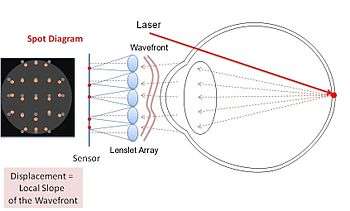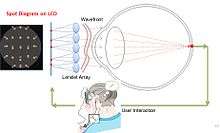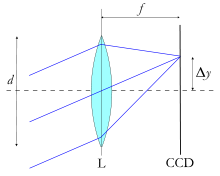Shack–Hartmann wavefront sensor




A Shack–Hartmann (or Hartmann–Shack) wavefront sensor (SHWFS) is an optical instrument used for characterizing an imaging system. It is a wavefront sensor commonly used in adaptive optics systems. It consists of an array of lenses (called lenslets) of the same focal length. Each is focused onto a photon sensor (typically a CCD array or CMOS array[1] or quad-cell[2]). The local tilt of the wavefront across each lens can then be calculated from the position of the focal spot on the sensor. Any phase aberration can be approximated by a set of discrete tilts. By sampling an array of lenslets, all of these tilts can be measured and the whole wavefront approximated.
Since only tilts are measured the Shack–Hartmann cannot detect discontinuous steps in the wavefront.
The design of this sensor was based on an aperture array that had been developed in 1900 by Johannes Franz Hartmann as a means of tracing individual rays of light through the optical system of a large telescope, thereby testing the quality of the image.[3] In the late 1960s, Roland Shack and Ben Platt modified the Hartmann screen by replacing the apertures in an opaque screen by an array of lenslets.[4][5] The terminology as proposed by Shack and Platt was Hartmann screen. The fundamental principle seems to be documented even before Huygens by the Jesuit philosopher, Christopher Scheiner, in Austria.[6]
Shack–Hartmann sensors are used to characterize eyes for corneal treatment of complex refractive errors.[7][8] Recently, Pamplona et al.[9] developed an inverse of the Shack–Hartmann system to measure one's eye lens aberrations. While Shack–Hartmann sensors measure localized slope of the wavefront error using spot displacement in sensor plane, Pamplona et al. make the user shift the spots till they are aligned. The knowledge of this shift provides data to estimate the first-order parameters such as radius of curvature and hence error due to defocus and spherical aberration.
References
- ↑ T Nirmaier; G Pudasaini; J Bille (2003). "Very fast wave-front measurements at the human eye with a custom CMOS-based Hartmann-Shack sensor". Optics Express. OSA. 11: 2704–2716. doi:10.1364/oe.11.002704.
- ↑ LP Salles; DW de Lima Monteiro (2010). "Designing the response of an optical quad-cell as position-sensitive detector". IEEE Sensors. IEEE. 10: 286–293. doi:10.1109/jsen.2009.2033806.
- ↑ Hartmann, J. (1900). "Bemerkungen über den Bau und die Justirung von Spektrographen". Zeitschrift für Instrumentenkunde. Berlin: Julins Springer. 20: 17–27, 47–58.
- ↑ Platt, Ben C.; Shack, Ronald (October 2001). "History and Principles of Shack-Hartmann Wavefront Sensing". Journal of Refractive Surgery. 17 (5): S573–7. PMID 11583233.
- ↑ Shack, R.V. (1971). Smith, F. Dow, ed. "Production and use of a lenticular Hartmann screen". Journal of the Optical Society of America (Oral presentation). Ramada Inn, Tucson, Arizona. 61 (5): 656.
- ↑ Scheiner, "Oculus, sive fundamentum opticum," Innsbruck 1619
- ↑ E. Moreno-Barriuso & R. Navarro (2000). "Laser ray tracing versus Hartmann--Shack sensor for measuring optical aberrations in the human eye". JOSA A. Optical Society of America. 17 (6): 974–985. doi:10.1364/JOSAA.17.000974.
- ↑ Thomas Kohnen & Douglas D. Koch (2006). Cataract and refractive surgery, Volume 2. Springer. p. 55. ISBN 978-3-540-30795-2.
- ↑ Pamplona, Vitor F.; Mohan, Ankit; Oliveira, Manuel M.; Raskar, Ramesh (2010). "NETRA: Interactive Display for Estimating Refractive Errors and Focal Range" (PDF). ACM Transactions on Graphics. 29 (4). doi:10.1145/1778765.1778814.